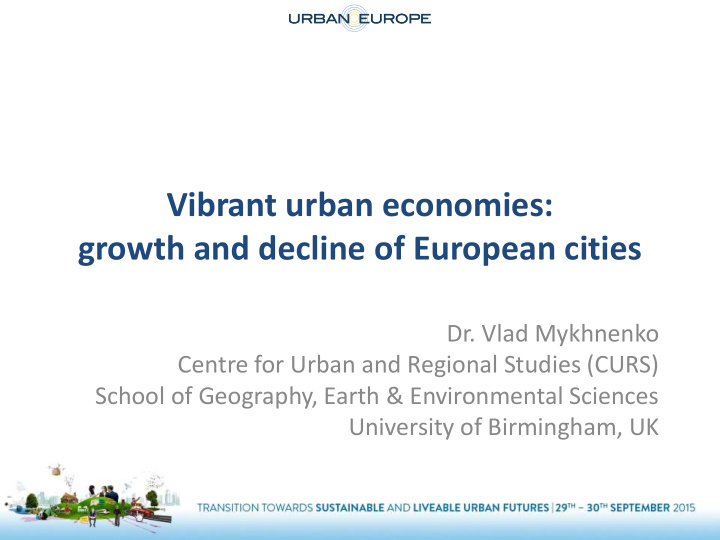



Vibrant urban economies: growth and decline of European cities Dr. Vlad Mykhnenko Centre for Urban and Regional Studies (CURS) School of Geography, Earth & Environmental Sciences University of Birmingham, UK
Vibrant Urban Economies - Rationale: Building resilient and resourceful cities - urban living environments capable of withstanding and successfully responding to the immediate shocks and long- standing ‘slow - burn’ effects of the economic crises, demographic shifts, and human-induced climate change. Clydesdale Paint Works 104-106 Tradeston Street, Glasgow, G5 8BG
City of London by Jack Torcello (19/09/2008) Vibrant Urban Economies – Focus on: “Cities with rapid economic growth and severe decline as well as cities with a re-growing economy ”; “Expressions of vibrancy [that] No. 29, 1905 Revolution Street, are closely related to Łódź population dynamics in terms by Łódź Rysowana Światłem (20/02/2008) of growth or shrinkage. Economically prosperous cities experience in general in- migration of people from declining regions but also immigration from abroad . In contrast, economically declining cities experience population loss , mostly of the young generation” (JPI UE, 2015: p. 26); Links between economic Leipzig, Alma Mater Lipsiensis performance and labour (Universität Leipzig) by Heribert Pohl market outcomes. (15/07/2014)
‘An evolutionary - historical geographical political economy’ perspective on growth and prosperity • The economic: path- dependent nature of uneven development (i.e., circular & cumulative causation); • The political: agents and territorial-admin structures of (resistance to) change; • Institutions; • History: evolutionary orientation / ‘creative destruction’ • Multi-scalar details and spatial-temporal dimensions.
Vibrancy in spatial economies: long-standing issues of scale, politics (power), and history (core- periphery) By NUTS3 regions By NUTS1 regions Mosaic blocks National capitals Historical power brokers Gross domestic product (GDP) at current market prices ( € Purchasing Power Standard per inhabitant), 2011
Understanding the success and/or failure of agglomerations and smaller cities starts with recognising how uneven regional development is a combined , relational process. Robert Rowthorn (2010) Combined and Uneven Ron Martin (2015) Rebalancing the Spatial Economy: The Development: Reflections on the North – South Divide, Spatial Challenge for Regional Theory, Territory, Politics, Governance , Economic Analysis , 5:4, 363-388, DOI: 3:3, 235-272, DOI: 10.1080/21622671.2015.1064825 10.1080/17421772.2010.516445
Detecting labour market turbulence and its consequences for city liveability: spatial- temporal dimensions 2007 2014 Unemployment rates by NUTS 2 regions (%), 15 years old and over
Matching youth employment and economic growth opportunities: encouraging the inflow of capital and/or labour out-migration? Young people neither in employment nor in education and training by NUTS2 regions (%, NEET rates)
Urban economies, labour migration & population change: divergent trajectories Story 1: economic growth ↗ jobs ↗ population growth ↗ 2013 2007 Crude rate of total population change by NUTS 3 regions (%)
Urban economies, labour migration & population change: divergent trajectories Story 2 (Germany, Austria, etc): economic growth ↗ jobs ↗ population growth ↘ Population growth, decline, and stability across Europe, 1990-1995
Population growth, decline, and stability across Europe, 1995-2000
Population growth, decline, and stability across Europe, 2000-2005
Population growth, decline, and stability across Europe, 2005-2010
The governance of economic transitions: improving the quality, fostering resilience Solid functioning institutions, ‘good governance’, and responsive politics as prerequisites for effective urban The European Quality of policies of smart Governance Index (EQI), 2013 growth / shrinkage Charron, Nicholas, Lewis Dijkstra and Victor Lapuente . 2015. ‘Mapping the Regional Divide in Europe: A Measure for Assessing Quality of Government in 206 European Regions’. Social Indicators Research. vol 122 (2): 315-346.
Recommend
More recommend